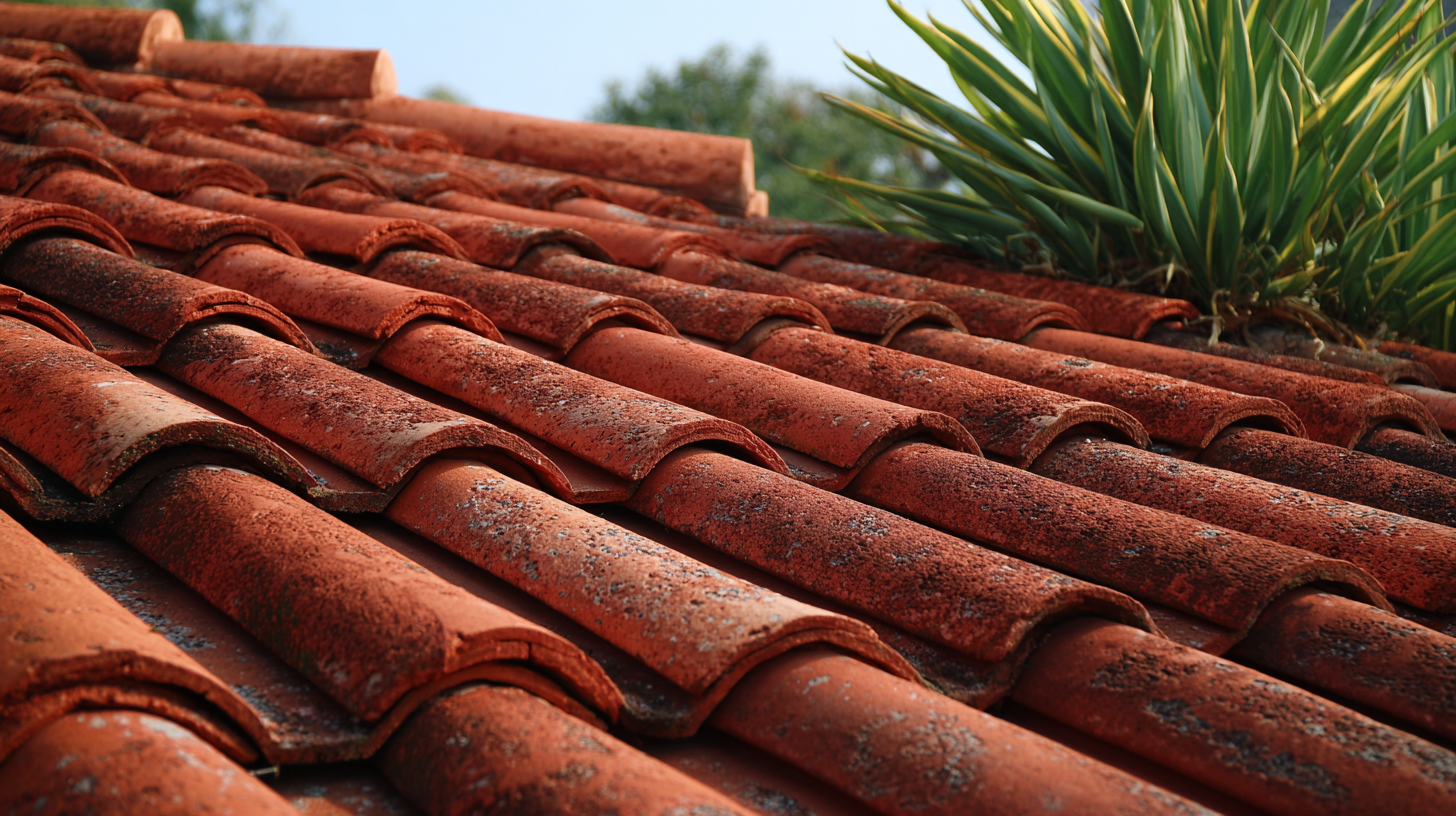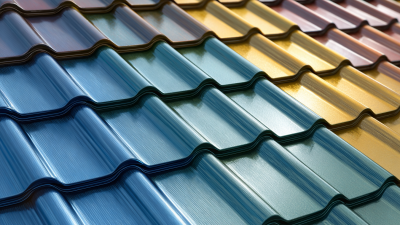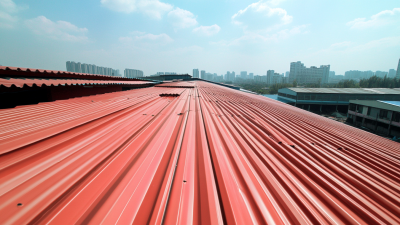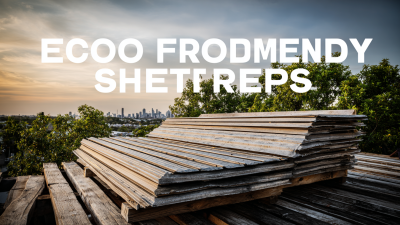
Leave Your Message
-
Phone
-
E-mail
-
Whatsapp

In recent years, the construction industry has increasingly recognized the importance of sustainable practices, aiming to reduce environmental impact and promote energy efficiency. Among the various innovations contributing to this green transformation, Eco-Friendly Roofing Tiles have emerged as a noteworthy solution. These tiles not only enhance the aesthetic appeal of buildings but also play a crucial role in minimizing energy consumption and improving indoor air quality. Their unique designs and materials help reflect heat, thus reducing reliance on air conditioning systems, which translates into significant energy savings.

Adopting Eco-Friendly Roofing Tiles in sustainable construction is more than just a trend; it is a commitment to building a healthier planet. By utilizing recycled or sustainable materials, these tiles contribute to reducing waste in landfills while lowering carbon footprints. Additionally, their durable nature ensures long-lasting performance, which reduces the need for frequent replacements and repairs. As environmentally conscious consumers demand greener building options, understanding the profound environmental benefits of Eco-Friendly Roofing Tiles can inspire builders, architects, and homeowners alike to embrace these innovative solutions for a sustainable future.
Eco-friendly roofing tiles are increasingly recognized for their positive environmental impact in sustainable construction. Unlike traditional roofing materials, these tiles are made from recycled or sustainably sourced materials, significantly reducing waste in landfills. The production process of eco-friendly tiles often utilizes less energy compared to conventional options, leading to a lower carbon footprint. Additionally, these tiles are designed to be more durable, which means they require less frequent replacement, further conserving resources over time.

Another key benefit of eco-friendly roofing tiles is their ability to enhance energy efficiency. Many of these tiles are designed to reflect sunlight, reducing heat absorption and minimizing the demand for air conditioning in warm climates. This not only lowers energy consumption but also contributes to a cooler urban environment, combating the heat island effect prevalent in many cities. By integrating eco-friendly roofing solutions into construction, builders can significantly mitigate the overall environmental impact of buildings, contributing to a more sustainable future.
When considering roofing materials for sustainable construction, it’s essential to compare traditional options with eco-friendly alternatives. Traditional roofing materials like asphalt shingles and concrete tiles may be cost-effective, but they often have significant environmental drawbacks. These materials can contribute to higher energy consumption due to poor insulation and are not recyclable at the end of their lifecycle, leading to increased waste in landfills.

On the other hand, eco-friendly roofing tiles are designed with sustainability in mind. Made from recycled materials, natural clay, or sustainably sourced wood, these tiles not only reduce environmental impact but also enhance energy efficiency by reflecting heat and improving insulation. This means lower energy bills and a reduced carbon footprint over time. Moreover, many eco-friendly options are durable and require less maintenance, providing long-term benefits to homeowners.
Tips: When selecting roofing materials, consider those labeled with environmental certifications to ensure you are making a responsible choice. Additionally, look for tiles that offer energy-efficient properties to further enhance your home’s sustainability. Lastly, consult with professionals who specialize in green building practices to find the best options tailored to your region's climate.
Eco-friendly roofing tiles are becoming increasingly prominent in sustainable construction due to their remarkable energy efficiency and thermal insulation properties. These innovative materials are designed to minimize heat absorption, ensuring that buildings remain cooler in the summer and warmer during winter months. By reflecting sunlight instead of absorbing it, eco-friendly tiles reduce the demand for air conditioning, thereby lowering energy consumption and reducing greenhouse gas emissions. This efficiency not only contributes to lower utility bills for homeowners and businesses but also enhances overall energy sustainability.
In addition to their energy-saving benefits, eco-friendly roofing tiles offer superior thermal insulation. They create an effective barrier against temperature fluctuations, which helps maintain comfortable indoor environments. This quality is particularly beneficial in regions with extreme weather conditions, where consistent indoor climates are essential for comfort and energy management. By improving insulation, these roofing materials help decrease reliance on heating and cooling systems, further promoting sustainability and energy conservation in the construction industry. Overall, integrating eco-friendly roofing tiles into building designs aligns with the principles of sustainable construction while providing significant long-term benefits.
Eco-friendly roofing tiles are increasingly recognized for their longevity and minimal maintenance requirements, making them a key component of sustainable construction practices. Unlike traditional roofing materials, which may deteriorate over time or require frequent replacements, eco-friendly tiles are often made from durable materials such as recycled metals, clay, or composite substances designed to withstand harsh weather conditions. This durability not only provides a longer lifespan for the roof but also reduces waste, as fewer materials end up in landfills over the years.
The maintenance of sustainable roofing solutions is another significant advantage. Many eco-friendly tiles are resistant to mold, algae, and other environmental threats, meaning they require less frequent cleaning and treatments compared to traditional options. This low maintenance not only saves homeowners time and money but also minimizes the use of harmful chemicals associated with roof care. By choosing eco-friendly roofing tiles, builders and homeowners contribute to a more sustainable building ecosystem while enjoying the long-lasting benefits and reduced upkeep.
Incorporating eco-friendly roofing tiles in sustainable construction not only enhances the aesthetic and environmental appeal of buildings but also offers significant cost-effectiveness. Many green roofing materials, such as recycled tiles or sustainably sourced clay, can have lower lifetime costs when considering their durability and energy efficiency. These materials reflect solar heat, reducing cooling expenses during the warmer months, which can be especially important in regions with high energy costs.
For homeowners and builders looking to make eco-friendly choices, several incentives can significantly offset initial investments. Governments often provide tax credits, rebates, or grants to encourage the adoption of green technologies. It's vital to research local programs that support sustainable construction practices.
Tips: Always request multiple quotes from contractors experienced in eco-friendly roofing. Look for materials with a proven track record of energy efficiency and sustainability. Consider engaging with local environmental agencies, as they can offer valuable information about available incentives and best practices in sustainable building.





